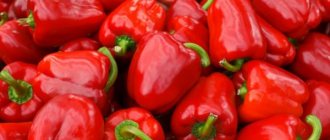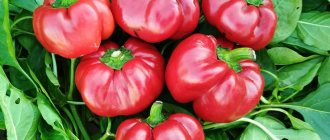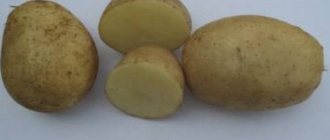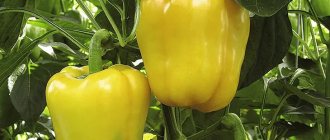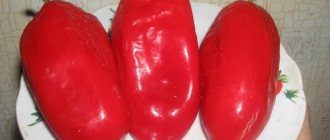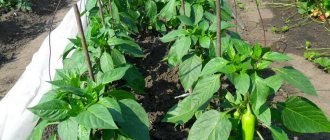Description and characteristics of the variety
Sweet pepper Victoria belongs to the category of early species. The stage of technical ripeness and harvesting begins after 105-110 days. The culture is standard. The variety has small semi-spreading bushes. The length of the stems does not exceed 50-60 cm.
It is convenient to grow peppers in beds under film and in small tunnels.
Story
The variety was created by breeders from Moldova. The base for breeding was Lastochka and Gift of Moldova. Southerner bears fruit well in warm areas (Moldova, Ukraine, southern Russia). When cultivating in cool areas, planting is carried out in covered beds or in greenhouse structures.
After the seedlings take root, cold resistance increases. It is advisable to plant bushes after return frosts.
Appearance
Bell pepper Victoria is a classic in the line of similar varieties. Its fruits are brightly colored ruby when fully ripe. They have the shape of a cone with weakly defined 4 edges. What are the signs of peppers:
- average weight 90-100 g;
- length 8-10 cm;
- diameter 4-5 cm;
- wall thickness 6-7 mm;
- the skin is durable.
Utility
Victoria red pepper contains many useful substances - carotene, antioxidants, anthocyanins. Contains a variety of vitamins and microelements:
| Vitamins | Minerals |
| A | Potassium |
| E | Calcium |
| WITH | Magnesium |
| RR | Iodine |
| Group B | Phosphorus |
Viability
The variety is well adapted and is not afraid of common pathogens. Low susceptibility to the disease has been identified for the following infections:
- VTM;
- verticillium;
- black rot.
Thanks to their resistance to the listed pathogens, the fruits are well transported and can be stored for up to 4-5 weeks. Storage is carried out in the cellar, in vegetable warehouses at 5-7 degrees.
Description of Victoria pepper, reviews, photos
An early-ripening, cold-resistant variety of sweet pepper of universal use for growing in open ground and under film covers.
This is one of the best varieties of domestic selection. The period from germination to technical maturity is 115-120 days. The bush is semi-spreading, compact, standard, 45-60 cm high. Shaping is desirable: removal of all side shoots and leaves before the first fork.
Victoria sweet pepper is included in the State Register of the Russian Federation and approved for use in the Central Black Earth and North Caucasus regions since 1979.
Fruit characteristics
The fruits are hanging, cone-shaped, smooth, in the stage of biological maturity, red in color, weighing up to 100 grams, 7.5 - 11 cm long, excellent taste. The pulp is juicy, sweet, aromatic. Wall thickness 5-7 mm. These peppers are suitable for fresh use and canning.
Variety value : high yield, excellent taste, disease resistance.
Productivity : up to 5 kg of fruits per 1 sq. meters of planting (subject to watering and fertilizing).
The variety is relatively resistant to black mold.
Growing and care
To get a good harvest, adhere to the following algorithm:
| Care techniques | Nuances |
| Watering | Use a drip or hose system Water is poured into the root zone Moistening frequency up to 2 times a week |
| Mulching | The mulch is laid out in a layer of 6-7 cm. Rotted sawdust, dry hay and straw are used. |
| Feeding | Up to 4 fertilizers are required per season Alternate minerals and organics The procedure is repeated after 2-3 weeks It is especially important to fertilize the beds before planting (spring or autumn) and water the plants with a nutrient solution during flowering and ripening |
| Weeding and loosening | Weeds are removed once every 10 days. Hoes and choppers are used to cultivate the beds. |
Features of growing Victoria pepper, planting and care
Sowing pepper seeds for seedlings is carried out 65-70 days before the intended planting of plants in a permanent place. The optimal temperature for seed germination is 26-28°C.
When true leaves appear on the plants, they are transplanted into separate cups with a capacity of 0.3-0.5 liters.
Pepper does not like transplanting, so do not be surprised if after you have transplanted the seedlings into separate containers, they stop growing for a while. You can “smooth out” the stressful state a little by spraying the plants with Epin.
When to plant pepper seedlings in the ground
After the threat of return frosts has passed, the seedlings can be planted in a permanent location. Some people plant in open ground in May, while others only plant under covering material or under film; it all depends on the climatic conditions of your region.
When planting pepper seedlings in the ground for 1 sq. It is recommended to place up to 5 plants per meter of plot. Peppers are planted in the ground without being buried, but in exactly the same way as they grew in cups. Pepper plants, unlike tomatoes, very rarely produce lateral roots, so there is no point in deepening them.
Pepper responds well to watering and fertilizing with complex mineral fertilizers. During the summer, 2-3 feedings are usually done.
Pest Control
The main parasites are slugs, ticks and Colorado potato beetles. Getting rid of them is easy if you use the right drugs. It is advisable to carry out preventive spraying with folk remedies.
Colorado beetle
Damage is caused by larvae and adults. To process the whole plant, use Regent, Commander, Prestige, Taboo. The roots are soaked in Aktar.
Spider mite
The parasite infects leaf blades, causing wilting and stunted growth. To cope with the pest, garlic, bitter solutions, as well as chemicals are prepared. The bushes are sprayed 2-3 times at weekly intervals.
Recommendations for cultivation
Like other varieties of sweet pepper, Victoria is grown by seedlings. Seeds are planted for seedlings in February.
After 8-10 weeks from the appearance of the first shoots, the finished seedlings can be planted in a permanent place. As a rule, this period falls on May - early June. Victoria is perfect for both greenhouses and open ground. At the same time, it can perfectly adapt to any, even the most difficult soils.
Important! Despite the fact that Victoria pepper is cold-resistant, when planting in open ground you should wait until the frosts are over.
Plants should be planted no more often than every 50 cm. Victoria has one more feature: from its plants it is necessary to remove all side shoots and leaves before the first fork of the trunk. If this is not done, the bush will begin to branch heavily and grow green mass instead of fruits.
You need to care for Victoria plants in the same way as any other variety of sweet pepper, namely:
- water regularly;
- weed;
- loosen;
- fertilize.
The harvest is harvested from July to September. At the same time, it is quite well stored and transported.
Every year, many gardeners and gardeners choose Victoria to plant on their plots, and this is perhaps the best business card.
Pepper variety "Victoria": key characteristics and agricultural technology of the crop
Growing sweet peppers in personal plots is a task that many gardeners face. That is why most summer residents strive to find the most productive variety. An excellent solution, according to many gardeners, is Victoria pepper. This vegetable crop produces good fruits, the appearance of which can be assessed from the photo. High yield and friendly shoots are other advantages of the variety. When describing this plant, it is also worth noting the excellent taste of the fruit.
Key features of the Victoria pepper variety
“Victoria” is a variety of sweet peppers created by breeders from Moldova back in 1979. The variety was the result of crossing the “Swallow” and “Gift of Moldova” peppers. The resulting plant is recommended for cultivation:
- in the North Caucasus;
- in Ukraine;
- in the Central Black Earth region of Russia.
The Victoria sweet pepper variety manifests itself in different ways.
Often this variety is early ripening if conditions for the vegetable crop are favorable. In areas where summer temperatures are low, the variety appears to be mid-season. As a rule, technical ripeness of fruits occurs in 110-130 days. As for the period of biological maturity, it averages 140 days.
Bushes of the Victoria variety are semi-standard or standard. They belong to the category of medium-sized plants. As a rule, the height of the vegetable crop does not exceed 45-60 cm. The bushes of the plant are semi-spreading. At the same time, the compact vegetable crop is excellent not only for growing in open beds, but also under film covers or in small greenhouses.
Description of vegetable fruits
One of the key features of the Victoria vegetable crop is cold resistance. That is why the variety is considered an ideal solution for most Russian latitudes. Other advantages include the variety’s resistance to:
- black rot;
- verticillium wilt;
- tobacco mosaic.
The fruits of the Victoria sweet pepper are slightly ribbed, drooping, and smooth. Their shape resembles a cone. During technical ripeness, vegetables are distinguished by a light green color. When peppers enter the stage of biological maturity, their surface acquires a rich red tone.
The vegetables this variety produces are quite large. Their weight varies from 70 to 100 g. At the same time, the length of the fruits, as a rule, does not exceed 11 cm. Another feature of the vegetable crop is the presence of thick walls. This parameter ranges from 5-8 mm.
The high productivity of the variety can also be noted. From 1 sq. m. you can collect about 7 kg of vegetables.
Another feature of the fruits of the Victoria variety is their excellent taste. Peppers are rich in ascorbic acid. This is why vegetables are suitable for fresh consumption. Peppers can also be used for making salads, stewing and canning.
The pulp of this variety of peppers is very tender, sweet and juicy. It is characterized by an expressive aroma.
Some tips for growing the variety
"Victoria" is cultivated by seedlings. Seeds for seedlings are planted in prepared soil in February. As a rule, from the moment of sowing to planting the seedlings, it takes from 8 to 10 weeks. Usually, seedlings are brought to a permanent place in May or early June. A unique feature of the variety is that the vegetable crop is able to adapt to any conditions, including rather difficult soil.
According to reviews from gardeners who have already cultivated the Victoria variety, you should not transfer seedlings to open ground when the risk of frost is still present.
When planting a vegetable crop, it is recommended to leave at least 50 cm between the bushes. When growing this variety, you should also systematically remove all the leaves located up to the first fork on the trunk and side shoots. Otherwise, the plant branches heavily, which leads to an increase in greenery and a reduction in the number of fruits.
The agricultural technology of this variety is considered standard. The plant requires weeding, regular watering, fertilizing and loosening the soil.
"Victoria" is a variety of sweet pepper that is well known to many gardeners. Summer residents appreciate the high yield, unpretentiousness, excellent taste of the fruit and extreme simplicity in the growing process. The plant will appeal to both experienced and novice gardeners.
Characteristics and description of the Victoria pepper variety
Sweet pepper Victoria was obtained as a result of selective crossing of old varieties Podarok Moldova and Lastochka, by breeders of the Moldavian Research Institute of Agriculture and Vegetable Growing.
The result is a sweet pepper that is dark red in color at full biological maturity, and light green in color at technical ripeness.
Main characteristics of pepper:
- Bush shape. The bush of the plant is compact, shaped like a small tree, not spreading, with a maximum height of up to 60 cm.
- The fruits are cone-shaped, up to 11 cm long, fleshy walls, 4-10 mm thick.
- Fruit weight is on average about 60 g.
According to the degree of ripening - early ripening. In some sources, the Victoria variety is classified as mid-season - this refers to more northern regions, where the timing of planting, ripening and harvesting shifts due to weather conditions.
Victoria red pepper is suitable for growing in beds, greenhouses and small film greenhouses.
Agrotechnical measures
Victoria pepper is grown in seedlings, like most other varieties. The time for sowing seeds is the end of February, March. You can sow in early April, but then the period of fruit ripening will be somewhat delayed.
You may be interested in: Favorable days for picking pepper in 2021 according to the lunar calendar Favorable days for planting pepper for seedlings in 2021: terms and rules for sowing at home Favorable days for sowing sweet and bitter pepper for seedlings in 2021
Pepper seeds are placed in prepared containers at a distance of 2 cm from each other, and to a depth of no more than 2.5 cm, and sprinkled with earth on top.
The period of planting in a permanent place begins 8-10 weeks after the appearance of the first shoots.
Attention! Victoria pepper is a cold-resistant variety, but night frosts and temperatures close to zero are still harmful to it, so planting should be done after stable temperatures have been established, or covered with film.
Pepper loves loose and fertile soil. If the site has clay soils, you need to dilute them with organic matter, peat and sand. Optimal bush planting scheme: 50x50.
Advantages and disadvantages
Features of the variety:
- The main advantage of this pepper variety is its cold resistance, which makes this variety popular among gardeners in the Central Black Earth region of Russia, Ukraine and the North Caucasus.
- Tender and juicy pulp, excellent taste, which makes it favorite for fresh consumption. Despite its tenderness, it has proven itself well in heat treatment and canning.
- Resistant to transportation. Has a long fresh shelf life.
- Resistance to black rot and other major diseases of peppers.
No disadvantages have been identified in this variety.
We destroy pests and fight diseases
In order to prevent the occurrence of any sweet pepper diseases, you must:
- observe crop rotation;
- avoid thickening of plants;
- Be sure to disinfect seeds;
- carry out proper watering and fertilizing.
Peppers are harmed by slugs, aphids, and spider mites. To prevent these pests from threatening the plants, it is necessary to regularly inspect the peppers, spray them with infusions of fragrant herbs (wormwood, tansy), ash or garlic infusion. Dusting the rows with wood ash and tobacco helps a lot.
It is recommended to use chemicals only in cases of severe plant damage.
